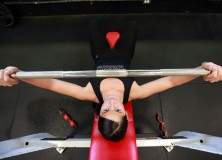
LEARNING THE DIFFERENCES BETWEEN FAST- AND SLOW-TWITCH MUSCLE FIBERS CAN HELP YOU DIVERSIFY YOUR TRAINING PORTFOLIO WHILE PROVIDING IMMEDIATE BODY BENEFITS.
Adding a little common sense to training is a great way to get the added advantage of seeing gains in your strength and size. When it comes to muscular development, it’s best to optimize the function of your muscles by being properly educated on their role in exercise.
MUSCLE FIBER TYPES
You’ve likely heard before that there are different classifications of muscle fiber types. For simplicity’s sake, we’ll categorize them as basic fast-twitch and slow-twitch muscle fibers. The fast-twitch fibers are often emphasized as the main group to zero into when strength training because they’re the strongest, largest, most explosive and controlled by high threshold motor units. Training explosively and using sets that don’t last much longer than 10-15 seconds with relatively heavy loads is the greatest way to tap into these capacities. It makes sense, but it can throw some lifters off and start making lifters prioritize these things at all costs — even when the muscles in question aren’t “fast-twitch dominant.”
It’s logical to think that muscles that have a higher endurance threshold functionally would be muscles that aren’t as loaded with fast-twitch muscle fibers as certain others. For example, the role of the postural muscles surrounding the scapulae is to maintain an upright, tall posture for the duration of the entire day. Most people don’t even report fatigue from doing this (showing the endurance-based makeup of these muscles). Muscles like the soleus, low back, quads and forearms would also fit into the category of groups that require higher endurance thresholds than areas like the deltoids, triceps, chest, or psoas.
The take-home here is that higher-rep endurance training shouldn’t be something to shy away from with select muscle groups when it comes to making them grow. Increased time under tension and higher rep ranges will help certain groups respond very well in terms of development. Don’t believe me? Think of the nature of speed skating, skiing or cycling and the associated upper leg development (specifically quads) that those athletes tend to carry. Surely, heavy lifting for low reps is an important part of their training, but it shouldn’t discount the fact that in each case their sport event heavily relies on the sustained output and muscular endurance of the quadriceps. Playing the sport itself is what these athletes do in the majority, and the leg development they carry largely has to do with the imposed demands of the sport. The same could be said about rowers and their upper back development. It makes perfect sense when you take a second to think about it.
With that said, take the opportunity to infuse extended sets with exercises like squats and pull variations like rows, and to hit the forearms and postural muscles by doing farmers walks and other kinds of loaded carries. They’re not just for your aerobic conditioning – you can also help your muscles get swole by doing them. Low rep sets of the big lifts and upper body presses are fine. But there will be limited benefits from doing sets of 6-8 reps seated rows or face pulls. Instead, use shorter rests and crack out sets of 15 or even 20 on occasion to engage the multiple muscle fiber types fully. You’ll be glad you did.


